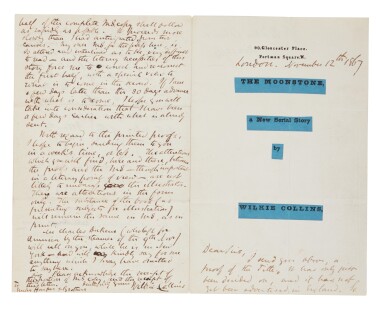
Collins, Wilkie | The foundation of modern detective fiction
Lot Closed
December 9, 08:28 PM GMT
Estimate
10,000 - 15,000 USD
Lot Details
Description
Collins, Wilkie
Proof title for The Moonstone, incorporating an autograph letter signed ("Wilkie Collins"), to his American publishers, Harper Brothers
2 pages (176 x 225 mm). On stationery embossed with Collins's "90 Gloucester Place. Portman Square.W." address, dated 12 November 1867 on the proof; old folds, short split to fold.
"Dear Sirs, I send you above, a proof of the title. it has only just been decided on, and it has not yet been advertised in England..."
Collins's most beloved novel, The Moonstone, was published in book form in 1868. It is considered one of the earliest examples of modern detective fiction, and is certainly one of the most formative. Indeed, T.S. Eliot claimed that the genre had been "invented by Collins and not by Poe," further declaring The Moonstone to be "the first, the longest and the best of modern English detective novels" (Thomas 179). Whether credit should be conferred upon Poe or Collins, The Moonstone was the first in this genre to introduce and apply science as a structural theme, and it is this distinction that has rendered it such a landmark work.
"The first weekly part of the story will be published in 'All The Year Round', on Wednesday January 1st 1868," Collins writes in the present letter. "We shall therefore appear on both sides on the Atlantic on New year's Day." The author then goes on to note that he is sending the first half of the complete manuscript under separate cover, before explaining that the whole process has taken longer than anticipated, as "the literary necessities of the story force [him] to correct and re-correct." Given the narrative complexity of The Moonstone, it is unsurprising that the process proved more time-consuming than Collins had initially anticipated.
As Ira Bruce Nadel notes, "it was not until the spirit of modern science became a cultural force that the detective story could arise" (Nadel 239). Collins worked diligently to integrate the biological and physical sciences into The Moonstone, with medicine and chemistry driving the plot. By employing expressions of popular science—namely mesmerism (see lot 1003) and phrenology—along with investigation and intuition, Collins succeeding in creating a narrative structure in which the characters and readers alike could solve the mystery through rational thought and deduction. The narrative's concentration on science and its reaches unquestionably reflects Collins's "life-long interest in the subject, the natural consequences of his desire to provide a rational foundation for the mysteries contained in his fiction in addition to incorporating in his writing the advances in contemporary thought he believed were essential to comprehend his age" (Nadel 239).
The present letter ends with a mention of Collins's close friend and collaborator: "Mr Charles Dickens (who left for America by the steamer of the 9th Novr) will call on you, while he is in New York — and will kindly say for me anything I have omitted to say here." Collins adapted The Moonstone for the stage in 1877 (see lot 1034), the text for which was privately printed under Dickens's imprint.
A remarkable relic of a foundational work.
REFERENCES:
Collins, The Letters of Wilkie Collins, ed. William Baker and William Clarke, Vol. 2 (London: Macmillan, 1999), pp. 297-298; Nadel, "Science and 'The Moonstone'," in Dickens Studies Annual, Vol. 11 (1983), pp. 239-259; Thomas, “Detection in the Victorian Novel”, in The Cambridge Companion to the Victorian Novel, ed. by Deidre David (Cambridge: Cambridge University Press, 2001), pp. 169–191
You May Also Like










